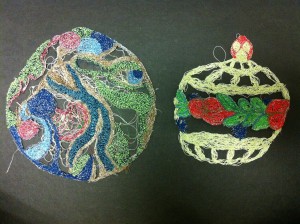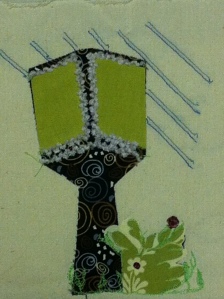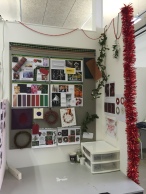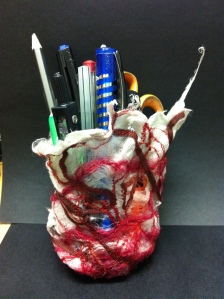Studio Space
Posted: October 21, 2015 Filed under: 'Consultancy' | Tags: Art, christmas, inspiration, mess, studio, Textile, theme Leave a commentMy studio space currently looks like a christmas explosion has occurred all over it. This is a good thing as I need to surround myself with christmas inspiration but it is rather busy which Im not very used to. I tend to prefer a neat clear board but for this project I am willing to accept it won’t be that way.
All things Stitch
Posted: November 25, 2013 Filed under: ADZ4777 Subject | Tags: Appliqué, Art, Cross-stitch, Embroidery, Sew, Sewing machine, Textile 1 CommentFor the first four weeks of this term every Tuesday I had a stitch workshop. I am quite confident when it comes to sewing with machines however these workshops were very useful to remind me of techniques I had learnt as well as learn new methods. We had a health and safety introduction which led on to us using the machines. We practised with the different programmed stitches, applique, free machine embroidery, hand embroidery and dissolvable fabric which we then moulded into 3D shapes – mine is currently being used as a pencil pot on my desk.
The main things which stood out to me when looking back over the

Sewn into disolvable material using imagery from my research and one of the trips to National Museum in Cardiff

I used bondaweb to hold the material while I appliqued it to the Calico. I also used free embroidery and the double needle stitch.
block of stitch Tuesdays were the hand embroidery and using a variety of threads in the machine. I have not experimented much with hand embroidery through out the last couple years of my education in Textiles since it was not always seen as a viable technique compared to others we had covered. However, since learning the variety of basic and more challenging stitches I have been inspired to incorporate them into my work I produce over the next two workshop days. The other skill I have learnt which has stuck in mind was using hand thread in the bobbin case when using the machines to create texture. The first time is a similar experience to when an artist who has only ever used a pencil then incorporates more defining materials such as charcoal or ink. My eyes were opened to the variety of other threads I could use through the machine and how I could develop my work and the texture produced further.
MAKING William Morris and the Arts and Crafts Movement by Prof. Jeff Jones
Posted: October 12, 2013 Filed under: ADZ4999 Constellation | Tags: 'we sit starving amidst our gold' by Jeremy Deller 2013, Art, Art for arts sake, Jeremy Deller, Pottery, William Morris Leave a commentThis image by Jeremy Deller is about the power of art and demonstrates the enduring power of William Morris as an artist as he throws the yacht into the lagoon. Deller has titled it with a quote from William Morris which also shows how this artist from the 1800s is still very much influencing art today.
The Arts and Crafts Movement and the aesthetic movement were in the late 1900s
two very different views of What Art Is
The Arts and Crafts Movement – ‘not possible to dissociate art from morality, politics and religion’ William Morris – artists are caught up in society
The Aesthetic Movement – ‘Art should be independent of all claptrap – should stand alone’ by James McNeill Whistler. Argument moto for this is art for arts sake
William Morris was an early socialist who demonstrated the signs of changes in 1888 when he said ‘aim of art to destroy the curse of labour’. One of Morris’ colleagues was John Ruskin who was an artist but is better known as an art theorist. One of his well known theoretical books is ‘The Stones of Venice’. In this book there is a section named the Nature of Gothic. Often called upon to illustrate and articulate certain ideas of art making and what it is about. Ruskin looks back into the history of work and art. He wrote about the system of work in the division of labour but his point was not the labour itself but the men who were divided.
Morris had noted in his diary when viewing the manufacture of carpets in May 1881 ‘each full waged girl must do 9ft of 4×4 per week to pay’ – this resulted in him setting up many manufacture companies to change this wrong doing of child labour.
Morris and Rossetti moved to Gloucestershire – Morris too much of a dreamer or visionary?
50 families moved from Chipping Campden High Street, London to Gloucestershire in 1902 (year of the Guild of the Handicraft). Twenny Pottery, Bridgend, South Wales
The Legacy of the Arts and Crafts Movement 20th Century studio crafts
Reginald Wells – designed pots to start off with but then wanted to make them himself
Bernard Leach set up the Leach Pottery in St. Ives, Cornwall in late 1940s
‘I spend my life ministering to the swinish luxury of the rich’ attributed to William Morris






Recent Comments